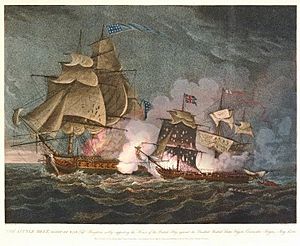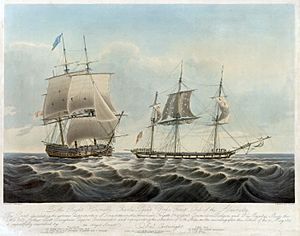Little Belt affair facts for kids
Quick facts for kids Little Belt Affair |
|||||||
|---|---|---|---|---|---|---|---|
| Part of the events leading to the War of 1812 | |||||||
 A 16 May 1811 engraving shows USS President battling HMS Little Belt |
|||||||
|
|||||||
| Belligerents | |||||||
| Commanders and leaders | |||||||
| Strength | |||||||
| 1 sloop-of-war 20 guns |
1 frigate 56 guns |
||||||
| Casualties and losses | |||||||
| 11 killed 21 wounded 1 sloop-of-war severely damaged |
1 wounded 1 frigate slightly damaged |
||||||
The Little Belt affair was a naval battle that happened on the night of May 16, 1811. It involved a United States frigate (a type of warship), the USS President, and a smaller British warship called HMS Little Belt. The Little Belt was a sloop-of-war, which is a smaller warship with fewer guns. This ship had originally been Danish but was captured by the British in 1807.
This fight happened off the coast of North Carolina. The Little Belt Affair was one of several important events that eventually led to the War of 1812 between the United States and Great Britain.
Contents
Why the Battle Happened
The Little Belt affair took place four years after another serious incident in 1807. In that event, a British ship, HMS Leopard, attacked an American ship, USS Chesapeake. Three American sailors were killed, eighteen were hurt, and four were taken by the British.
Just fifteen days before the Little Belt affair, another British ship, HMS Guerriere, had stopped an American ship called USS Spitfire. The British took an American sailor named John Diggio from the Spitfire. This act was called impressment, where British ships forced American sailors to join their navy.
Because of these problems, the American Secretary of the Navy, Paul Hamilton, ordered the President and another ship, USS Argus, to patrol the American coast. Their job was to protect American ships and sailors.
The Encounter
The Chase Begins
Commodore John Rodgers was in charge of the American frigate President. He had left Annapolis, Maryland, a few days earlier and knew about the incident with the Guerriere. He was sailing north along the coast when he saw a ship to the east around noon on May 16.
Rodgers thought the ship might be the Guerriere, so he decided to chase it. The captain of the Little Belt, Arthur Bingham, had seen the President an hour before. Bingham tried to signal the President to ask who they were, but he didn't get an answer. He did notice a blue flag that showed the ship was American.
Bingham continued sailing south, but Rodgers kept chasing him. Rodgers wanted to know for sure who the other ship was. By 3:30 PM, the President was close enough for Rodgers to see part of the British ship's back end. From that angle, the Little Belt looked bigger than it actually was. The Little Belt was much smaller than the President. The Little Belt had 20 guns, while the President had 56 guns.
The Battle Starts
What happened next is still debated, as the British and American stories are different. As the President got closer, Captain Bingham thought the American ship was trying to get into a position to fire all its guns along the side of his ship. Bingham turned his ship three times to avoid this.
The ships were not close enough to talk to each other until after the sun had set. Around 10:15 PM, both captains demanded that the other ship identify itself. Neither captain wanted to answer first. Each captain later said that he was the first to ask. Soon after this, a shot was fired. It is still not clear which ship fired first.
The ships quickly began fighting. The Little Belt was much smaller and had no real chance of winning against the powerful President. After about fifteen minutes, most of the Little Belt's guns were out of action. Commodore Rodgers then ordered his ship to stop firing. The President came back, and Rodgers asked Bingham if he had given up. Bingham said he had not, and the President moved away.
What Happened Next
The President had only one sailor injured in the fight. The Little Belt had nine sailors killed and 23 injured, two of whom later died. The British ship was also badly damaged. The next morning, an American officer went to the Little Belt to express regret about the fight and offer help. Captain Bingham refused the help. Bingham asked why the President had attacked his much smaller ship. The American officer said it was because the Little Belt had "provoked" the attack, but Bingham disagreed.
The President then sailed to New York City. The Little Belt went to Halifax, Nova Scotia, for repairs, escorted by another British ship, HMS Goree. The governments of Britain and America argued about this event for many months. Commodore Rodgers insisted that he thought the Little Belt was a larger frigate and that the British ship had fired first. The British Navy leaders supported Captain Bingham and promoted him in February 1812.
On August 19, 1812, after the War of 1812 had officially started, HMS Guerriere (the ship that had impressed the American sailor) sailed into a famous battle against USS Constitution. The words "NOT THE LITTLE BELT" were painted on her sail, showing that the British remembered the earlier fight.


